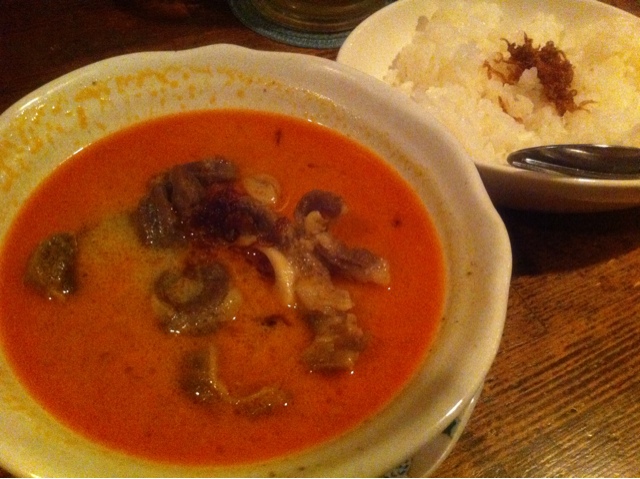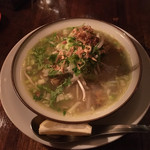
cabe 武蔵小山店
Chabe ◆ チャベ
3.09
Fudomae, Musashi-Koyama, Nishikoyama
「Indonesia cuisine」
3,000-3,999円
--
Opening hours: [Monday-Thursday 18:30-1:30 (L.O.) [Friday, Saturday 18:30-3:30 (L.O.)
Rest time: Sunday
東京都品川区小山4-3-13 2F
Photos
(20)




















Details
Reservation Info
Reservations accepted Calls will not be answered until after the 6:30pm opening. We are a one-person operation and may not be able to answer the phone. Please call again after a pause.
Children
This is a smoker-friendly restaurant. Please understand. The restaurant is very small and cramped, so strollers are not permitted.
Payment Method
Credit cards not accepted
Number of Seats
15 seats
(7 seats at counter, 2 x 4 seats at table)
Private Dining Rooms
None
Smoking and Non-Smoking
Smoking is permitted in all seats. As the Law Concerning Measures Against Passive Smoking (Revised Health Promotion Law) has been in effect since April 1, 2020, please check with the restaurant prior to your visit as the information may differ from the latest information.
Parking
None
Coin-operated parking available nearby
Facilities
Calm space, counter seating available, sports viewing available
Drink
Shochu available, wine available, cocktails available
Comments
(8)
みんへん
3.60
Located about a 3-minute walk from Musashi-Koyama Station on the Tokyu Meguro Line, "Cabe Musashi-Koyama" is an Indonesian cuisine dining bar. The entrance has counter seats, and there are two table seats in the back. It's a really deep place, where you can enjoy authentic Indonesian cuisine in a great atmosphere. This time, I had curry and another dish (forgot the name) shown in the photo. It's a bit spicy as you would expect from Indonesian cuisine, but it was really delicious! You can also use it as a regular bar, so this place is great!


Prozac
3.60
On a late Saturday night when I was starving and couldn't find any place to eat other than chain restaurants in Musashi-Koyama, I stumbled upon a unique spot. As soon as I climbed the stairs, I was transported to Southeast Asia. The smell of incense and Southeast Asian cigarettes filled the air. The interior had a calming vibe, making it easy to want to linger. The owner, who seemed like a hippie at first glance, was friendly and provided excellent service. The food was authentic Indonesian cuisine and delicious. The owner took the time to explain each dish, making it easy to try new things. The drinks were affordable, and they even had tropical juices which I enjoyed. If you love Asian cuisine and find yourself in Musashi-Koyama late at night, this place is a must-visit. The owner's love for Indonesia adds to the charm of the place. The music was unique, with Hawaiian tunes playing in the background, making the whole experience even more interesting.




☆まっちゃん
3.20
On February 15, 2016, I visited this restaurant for the first time with two friends. It is a dining bar that mainly serves Indonesian cuisine. The restaurant is located on the second floor near Musashikoyama's landmark "Gyutaro", with a somewhat mysterious entrance that made it feel a bit intimidating. The interior was dimly lit, and all the customers, including ourselves and the staff, were of Southeast Asian descent, giving the place a foreign dining bar atmosphere. We tried the "Tahu Isi" (350 yen), which is deep-fried tofu stuffed with vegetables. It was delicious, with crispy tofu filled with aromatic vegetables like coriander, served with a sweet Indonesian sambal sauce. We also had the "Sate Assortment" (1300 yen), which is Indonesian grilled skewers with various types of meat coated in a spicy and sweet peanut sauce. Although it was too authentic for my taste, the flavors were interesting. The "Ayam Goreng" (860 yen) was Indonesian-style fried chicken served with vegetable sticks and sambal terasi, a sauce made with shrimp paste. The chicken was fairly ordinary, but the sambal terasi added an Asian twist to the dish. The "Gulai Kambing" (850 yen) was a mutton curry that was surprisingly mild and delicious. We also enjoyed Indonesian beer "Bintang" (600 yen) and highballs (500 yen). Overall, if you're looking for authentic Indonesian cuisine in Musashikoyama, this restaurant is highly recommended.




尚@
3.60
After leaving Musashi-Koyama Station, walk along the terminal and cross Route 26, and you will soon reach the stairs of this restaurant. The entrance is narrow, so you might get a little lost. As you climb the stairs and open the door, you will catch a hint of fragrant spices. I feel like trying an Indonesian cigarette after a long time. I wonder if they still sell them at the cigar shop in front of Meguro Station. Upon opening the door, the scent is not as strong. The interior of the restaurant is dimly lit with several candles. There is a couple seated at the counter in the back, and I take a seat at the counter as well. Below are my impressions of the dishes I tried while enjoying Seabass and Arrack. Arrack (rice shochu): Smooth and not too strong in flavor. It's surprisingly easy to drink for a 35% alcohol content. Be careful not to drink too much! Unpin (fried sen): Made from the powder of the fruit of the Merinju tree, which is native to Indonesia. It has a slight bitterness, but it pairs well with alcohol. This bitterness is nice. When eaten with the sweet and spicy som dam sauce, it becomes even more delicious. Satay Ayam (chicken skewers with peanut butter flavor): Regular skewers with peanut butter spread on them. Garlic fries are served on the side. It's a bit bland in terms of meat flavor, but the peanut butter taste is delicious. Typically, this is what is referred to as satay. Satay Sambal (chicken skewers with sambal sauce): The meat is similar to Satay Ayam. The taste is spicy and sweet-sour. It's decent in terms of flavor. Satay Kambing (mutton skewers): The meat has a delicious marinade. It's slightly sweet, with the sweetness of onions enhancing the flavor of the mutton. There is no gamey taste. Satay Lilit (lemongrass-flavored meatball skewers): The meatballs have a crunchy texture due to the coconut pulp used as a binder. The coconut sweetness, sweet and spicy sauce, and lemongrass flavor of the marinade combine to create a complex taste. It's delicious. It's more enjoyable to eat it with the spicier som dam sauce provided, rather than the sweet and spicy pedas sauce. Lumpia (vegetable-filled spring rolls): The skin is slightly over-fried, but the filling is flavorful. The difference between this and regular spring rolls is astonishing. The filling is so rich that I suspected there was meat in it, but apparently not. Tahu Sis (thick fried tofu): Tofu stuffed with plenty of vegetables and fried. The outside is crispy, while the inside is soft. The vegetables are sweet, and when eaten with som dam sauce, it enhances the flavor. Siomay (shumai): It's too big to be called shumai. It's more like a petit man. Eaten with peanut sauce, it has a slightly sweet taste with a meaty filling that is tender and flavorful. It's more delicious when eaten with the spicier som dam sauce provided, rather than the sweeter pedas sauce. Mie Goreng (fried noodles): Topped with a firm fried egg. When eating this, break the egg while eating it. The taste is normal for Chinese fried noodles. The fried noodles I had in Jakarta and Bandung had a fiery spiciness, but this one lacks that. In Bali, they apparently add their homemade sweet and spicy sambal sauce to it. They also serve it with green chili peppers, Indonesian-style. It's delicious when eaten with sambal and som dam sauce. The spiciness adds to the flavor, and it's tasty. The cabbage is crunchy. Mie Ayam (dipping noodles): Stir-fried noodles dipped in soup. The soup has a chicken consomme-like flavor. The noodles are soft and have a homely taste. They claim not to use consomme. Even when adding the black sauce and som dam provided, the taste only becomes slightly sweet and savory. It's a simple and homely taste, which may appeal to some people. Indonesian cuisine undergoes a transformation in flavor when sauce is added. Without it, the taste is ordinary. The meat in this restaurant is certified with a halal mark.




ropefish
4.00
Midnight at Musashi-Koyama. There was a spicy smell in the air. And there it was - "Chabe." Wait, isn't that the name of the best Indonesian restaurant in the Meguro area... Could it be...? Climbing up the staircase filled with a certain vibe, and opening the door... Oh, what a marvelous cultural anthropological space. And indeed, this Chabe in Musashi-Koyama is part of the same group as the one in Meguro. And apparently, this one in Musashi-Koyama is the original store... Oh, I had no idea. Opening the menu, it was truly amazing. From curry to side dishes to snacks to drinks... a wide variety of authentic Indonesian dishes. It's irresistible. Bintang beer ¥630, Um Pin ¥350, and nut chips. Slightly bitter and crunchy, a perfect snack to go with Bintang beer. Gule Kambing ¥900 - Indonesian mutton curry. Comes with rice and it's a great deal for the price! And it tastes delicious too. Sometimes the meat is goat meat, which is also good. The flavor is just as fantastic as the store in Meguro. And the fact that they're open until 4 in the morning is just amazing. How come I didn't know about this great place until now...? The answer is simple. It was categorized as "Bar Izakaya" on Tabelog. It happens sometimes. There's another Indonesian restaurant nearby called "Prau Mera Cafe" which is open until late at night as well, and apparently, the Indonesian owner there used to be a customer at Chabe. A reliable restaurant. Highly recommended.




peony8
3.50
This place stays open until late at night (maybe until 4 am?). It's a great spot where you can enjoy delicious food and drinks while snacking. The interior of the restaurant has an Asian atmosphere with dim lighting, creating a cozy ambiance. It's perfect for when you want to relax. The dishes are authentic and satisfying, such as Yam Woon Sen and Mie Goreng. There are also many Indonesian customers who visit. When you go late at night and sit at a table in the back, the staff will leave you alone in a nice way so you can enjoy your time leisurely. It's great to have a place like this nearby. I have only been there late at night (after midnight...), so the atmosphere might be different earlier in the evening. This is a unique spot in Musashi-Koyama that I find very useful.


konnya
3.00
I was craving Asian cuisine and found this place nearby. There aren't many Southeast Asian restaurants in the Musashikoyama area, so I was happy to discover this one. The food is delicious and authentic, with a good amount of spices, herbs, and coconut flavors. However, it's primarily a bar so it's dark inside and not really suitable for family dinners. It's great for a relaxed drink though. My husband wants to visit with his friends. There is a sister restaurant on Meguro Street that seems to have a more spacious café-like atmosphere, so I'd like to check that out. They also welcome children.
タケゾウ
3.50
An Indonesian restaurant in Musashi-Koyama. Up the narrow staircase next to the eel shop, you'll find a mysterious ethnic space. The food is said to be made by locals and authentic. Plus, they're open until 4 a.m., which is a great convenience. Enjoying a Bintang beer while eating the dishes, you'll feel like you're somewhere else. Recommended for those who like Southeast Asian, ethnic vibes. It's great for couples or friends to leisurely drink and eat. Not ideal for loud parties, but perfect for a quiet and relaxed time.
Email Login